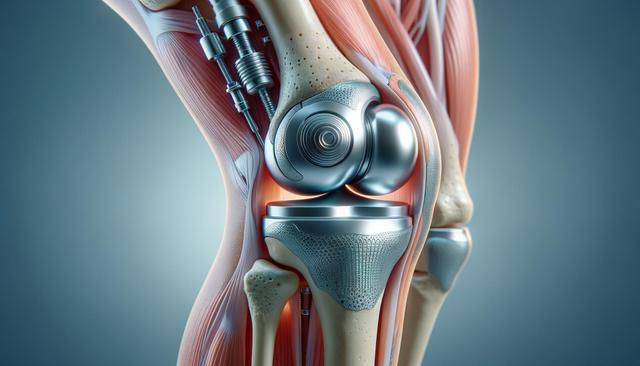What Is a Full Knee Replacement?
A full knee replacement, also called total knee arthroplasty, is a surgical procedure where damaged parts of the knee joint are removed and replaced with artificial components. This is typically recommended for individuals with chronic knee pain or arthritis that doesn’t respond to other treatments. The goal of the procedure is to restore function and reduce pain, allowing individuals to return to daily activities with greater ease.
During the surgery, the damaged cartilage and bone are removed from the surface of the knee joint and replaced with metal and plastic implants. These components are designed to mimic the movement of a natural knee. A full knee replacement addresses all three compartments of the knee, unlike partial replacements which only target one area.
Patients are usually considered for this surgery if they have:
- Severe osteoarthritis or rheumatoid arthritis
- Significant knee deformity
- Limited mobility impacting quality of life
- No relief from physical therapy or medications
Understanding the basics of the procedure helps patients prepare for the process and recovery ahead.
Why People Choose Full Knee Replacement
People opt for a full knee replacement when pain and stiffness begin to interfere significantly with daily life. In many cases, conservative treatments such as physical therapy, weight loss, or injections may be tried first. However, when these options fail, surgery becomes a viable solution.
Common reasons people choose this procedure include:
- Difficulty walking, climbing stairs, or getting up from a chair
- Knee pain that persists even while at rest
- Swelling and inflammation that do not subside with rest or medications
For individuals facing these challenges, total knee replacement can offer a significant improvement in quality of life. While it is a major surgery, the results often include improved joint function and long-term pain relief.
It’s important to have realistic expectations. The surgery can greatly reduce discomfort, but it may not restore the knee to its condition prior to joint damage. Discussing potential outcomes with a healthcare provider helps set a clear vision for recovery and results.
The Procedure: What to Expect
Full knee replacement surgery typically takes one to two hours and is performed under spinal or general anesthesia. The surgeon makes an incision over the knee, moves the kneecap aside, and removes the damaged joint surfaces. The artificial components are then securely fixed to the bone using special cement or a press-fit technique.
Patients usually stay in the hospital for a few days following the surgery. Pain management, early mobility, and physical therapy begin almost immediately to promote healing and prevent complications. Some important aspects of the hospital stay include:
- Monitoring for signs of infection or blood clots
- Guided physical therapy sessions
- Education on how to move safely post-surgery
Understanding each step of the procedure helps reduce anxiety and prepares patients for a smooth recovery process.
Recovery and Rehabilitation
Recovery from a full knee replacement can vary from person to person, but most individuals begin to see improvements within six weeks. Full recovery can take several months, depending on factors like age, overall health, and commitment to rehabilitation.
Rehabilitation is a crucial part of the healing process and typically includes:
- Physical therapy exercises to improve strength and flexibility
- Gradual increase in walking distance and activity level
- Regular follow-ups with the surgeon
During the first few weeks, patients are advised to use assistive devices such as walkers or crutches. As strength improves, these aids can be phased out. Adhering to a rehabilitation plan is essential for restoring function and achieving optimal outcomes.
Managing expectations during recovery is also important. While the pain from surgery subsides over time, slight discomfort or stiffness may persist for months. However, the overall goal of enhanced mobility and reduced pain is usually achieved when patients stay consistent with their recovery plan.
Long-Term Outcomes and Lifestyle Adjustments
Most people who undergo full knee replacement experience significant improvements in pain relief and mobility. The artificial joint is designed to last 15 to 20 years, and many patients are able to return to low-impact activities such as walking, swimming, or cycling.
To maintain the health of the new joint and ensure long-term success, patients should consider the following lifestyle adjustments:
- Maintaining a healthy weight to reduce stress on the knee
- Avoiding high-impact sports like running or heavy lifting
- Staying active with gentle, joint-friendly exercises
- Attending regular check-ups to monitor the joint
Adapting to life after surgery involves patience and attention to daily habits. Over time, many individuals find they can enjoy a more active and comfortable lifestyle than before the procedure.
While complications are rare, it’s essential to be aware of any signs of infection or implant issues and report them promptly. Ongoing communication with healthcare providers helps ensure the long-term success of the replacement and overall well-being.
Conclusion: Making an Informed Decision
Understanding full knee replacement is key to making informed decisions about treatment options. For those living with chronic knee pain that limits daily activities, this procedure can offer long-term relief and improved mobility. However, it’s important to weigh the risks and benefits, follow through with rehabilitation, and make necessary lifestyle adjustments post-surgery.
By working closely with medical professionals and maintaining realistic expectations, individuals can achieve a successful outcome and enjoy a better quality of life after knee replacement surgery.


